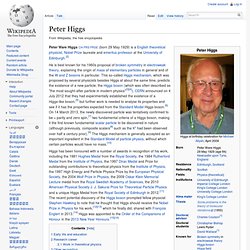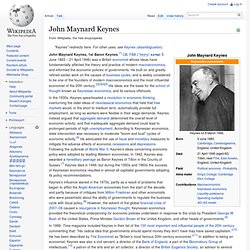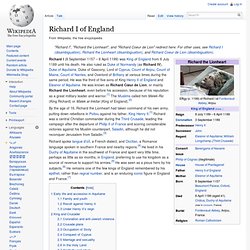

Peter Higgs. Nobel Prize Laureate Peter Higgs during press conference in Stockholm, December 2013 Peter Ware Higgs CH FRS FRSE (born 29 May 1929) is a English theoretical physicist, Nobel Prize laureate and emeritus professor at the University of Edinburgh.[2] He is best known for his 1960s proposal of broken symmetry in electroweak theory, explaining the origin of mass of elementary particles in general and of the W and Z bosons in particular.

This so-called Higgs mechanism, which was proposed by several physicists besides Higgs at about the same time, predicts the existence of a new particle, the Higgs boson (which was often described as "the most sought-after particle in modern physics"[3][4]). Early life and education[edit] In 1946, at the age of 17, Higgs moved to City of London School, where he specialized in mathematics, then in 1947 to King's College London where he graduated with a first class honours degree in Physics in 1950 and achieved a master's degree in 1952.
Research career[edit] John Maynard Keynes. John Maynard Keynes, 1st Baron Keynes,[1] CB, FBA (/ˈkeɪnz/ KAYNZ; 5 June 1883 – 21 April 1946) was a British economist whose ideas have fundamentally affected the theory and practice of modern macroeconomics, and informed the economic policies of governments.

He built on and greatly refined earlier work on the causes of business cycles, and is widely considered to be one of the founders of modern macroeconomics and the most influential economist of the 20th century.[2][3][4][5] His ideas are the basis for the school of thought known as Keynesian economics, and its various offshoots. In 1999, Time magazine included Keynes in their list of the 100 most important and influential people of the 20th century, commenting that: "His radical idea that governments should spend money they don't have may have saved capitalism.
"[10] He has been described by The Economist as "Britain's most famous 20th-century economist. Early life and education[edit] King's College, Cambridge. Edward I of England. Edward I (17 June 1239 – 7 July 1307), also known as Edward Longshanks and the Hammer of the Scots (Latin: Malleus Scotorum), was King of England from 1272 to 1307.

The first son of Henry III, Edward was involved early in the political intrigues of his father's reign, which included an outright rebellion by the English barons. In 1259, he briefly sided with a baronial reform movement, supporting the Provisions of Oxford. After reconciliation with his father, however, he remained loyal throughout the subsequent armed conflict, known as the Second Barons' War. After the Battle of Lewes, Edward was hostage to the rebellious barons, but escaped after a few months and joined the fight against Simon de Montfort. Montfort was defeated at the Battle of Evesham in 1265, and within two years the rebellion was extinguished. He spent much of his reign reforming royal administration and common law. Edward I was a tall man for his era, hence the nickname "Longshanks". Richard I of England. Richard I (8 September 1157 – 6 April 1199) was King of England from 6 July 1189 until his death.

He also ruled as Duke of Normandy (as Richard IV), Duke of Aquitaine, Duke of Gascony, Lord of Cyprus, Count of Anjou, Count of Maine, Count of Nantes, and Overlord of Brittany at various times during the same period. He was the third of five sons of King Henry II of England and Eleanor of Aquitaine. He was known as Richard Cœur de Lion, or mainly Richard the Lionheart, even before his accession, because of his reputation as a great military leader and warrior.[1] The Muslims called him Melek-Ric (King Richard) or Malek al-Inkitar (King of England).[2] Early life and accession in Aquitaine[edit] Family and youth[edit] Richard I's great seal of 1189 Richard was born on 8 September 1157,[8] probably at Beaumont Palace,[9] in Oxford, England.
Richard was said to be very attractive; his hair was between red and blond, and he was light-eyed with a pale complexion. Revolt against Henry II[edit] Nathan Mayer Rothschild. Nathan Mayer, Freiherr von Rothschild (16 September 1777 – 28 July 1836), known as Nathan Mayer Rothschild, was a London-based Ashkenazi Jewish banker and financier and one of five sons of the second-generation of the Rothschild banking dynasty.

He was born in Frankfurt am Main, the fourth child of Mayer Amschel Rothschild (1744–1812) and Gutle Schnapper (1753–1849). Life[edit] In 1798, at the age of 21, he settled in Manchester and established a business in textile trading and finance, later moving to London, England and making a fortune in trading bills of exchange through a banking enterprise begun in 1805. In 1816, his two elder brothers were granted noble status (Freiherr or Baron) by the Emperor of Austria. They were now permitted to prefix the Rothschild name with von or de.